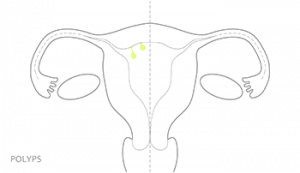Polyps

The inner lining of the womb contains glands and are responsible for the monthly menstrual bleed in pre-menopausal women. Sometimes, endometrial polyps can arise from this lining, taking the shape of a small grape, located within the cavity of the womb. The size of polyps may vary from a few millimetres, up to a few centimetres. They may be solitary or a few may exist at the same time. They often cause symptoms such as heavy menstrual bleeding, prolonged bleeding or unscheduled bleeding. Endometrial polyps are usually benign, although some may contain pre-cancerous changes. Cancerous polyps are uncommon in younger women.
The removal of endometrial polyps requires hysteroscopy (an endoscopic procedure, similar to keyhole surgery). There is no need for a surgical cut, as the endoscope is passed through the natural opening of the vagina and cervix to enter the womb.
Despite removal, endometrial polyps can still recur, especially those containing pre-cancerous changes. It is thus necessary to monitor and follow up after hysteroscopy and polyp removal.
